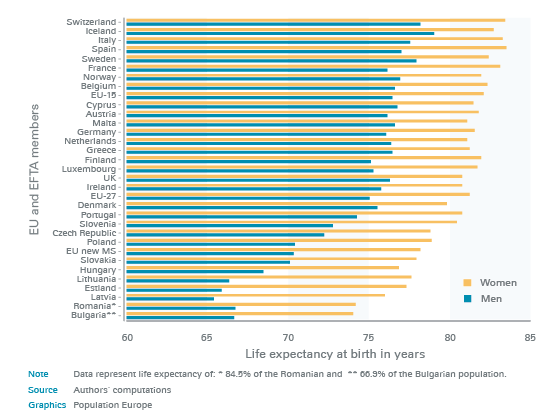Some European countries, mainly among the new EU member states, have significantly higher mortality rates than others. This gap between ‘old’ and ‘new’ member states is even wider when deaths before the age of 65 are considered. A study by Luc Bonneux, Corina Huisman and Joop de Beer from the Netherlands Interdisciplinary Demographic Institute (NIDI) explores the drivers of Europe’s health divide and evaluates the potential for prevention and improved health in the European Union.
Population statistics between 2002 and 2004 for most European countries show that on the whole, women live longer than men. For the 27 member states in the European Union (EU27) and Iceland, Norway and Switzerland as members of the European Free Trade Association, the authors of the study find that on average a newborn female child can expect to live 81.3 years, whereas her male counterpart will live 75.1 years. Country-specific differences in life expectancy and mortality rates are equally striking: In the new, mainly former socialist economies which joined the European Union after 2004 on average people live about 5 years less than those in the fifteen older member states (EU15). People live on average the longest in Switzerland, Iceland and Italy and expect the shortest life span in Bulgaria, Romania or Latvia with big differences in life expectancy between women and men [see Figure 1].

Figure 1: Life expectancy at birth by 27 EU and 3EFTA members, ranked by total life expectancy
The significance of death before the age of 65
Starting from these results, the research team goes one step further and uses the differences in life expectancy as indicators for the overall health of national populations. This is done by concentrating on deaths occurring before the age of 65, where in most cases a single factor or pre-condition can be identified as the cause of death. At older ages multiple diseases often co-exist and the cause of death cannot be clearly distinguished. This study shows that in the EU27 countries about two thirds of early deaths occur from three main causes: cancer, circulatory diseases and external causes such as injury or poisoning. And these early deaths account for 30% of the difference in female life expectancy between new and old European member states, and as much as 60% of the difference for men.
Drivers of the health divide in Europe
Considering further these differences between countries, scientists find that stroke, ischemic and other heart and digestive diseases affect women and men alike but shorten lives in the new member states much more than in the old EU countries. Additionally, external causes such as traffic accidents are often responsible for more male deaths. The researchers have also shown a high inequality of cancer as a cause of death between old and new member states.
The potential of prevention
Strikingly, many of these causes of death are strongly related to avoidable factors: smoking, alcohol, an unhealthy diet and sedentary lifestyle, as well as unsafe roads or insufficient screening programmes such as for cervical cancer, which shorten the lives in the new member states so dramatically. To unify Europe it is necessary to also homogenise the status of health. To monitor this process reliable data and good analysis are important. The results of this study show that there is still much to do. “In Europe, health inequities are caused by very traditional causes of poor health: smoking, excessive alcohol consumption, mortality from injury and suicide and deficiencies in access of health care”, the authors point out.
If the new EU countries put some effort into tackling the early deaths before 65 they could lengthen the average life expectancy for men by about 4 years and that of the women by about 1.5 years. Changes in lifestyle and prevention programmes offer substantial potential to reduce the health divide in Europe.
This PopDigest is also available in French, Spanish and German.
This volume has been published with financial support of the European Union in the framework of Population Europe.